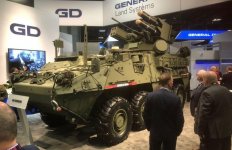Sorry for popping up again
But I knew I'd seen it somewhere.
Pg 37 of the GBAD presentation - GBAD Concept of Operations - M777s providing Counterbattery fire.
Also, a fixed Command Centre within the Brigade Area of Operations with manoeuvre elements working under an Airspace Coordination bubble.
I am guessing that the AD requirements would be different at Suffield, Pet and Gagetown, or for that matter Kananaskis Country. Which do you plan for? Knowing that whatever you choose the enemy will do the other thing.
And for the record - I thought we looked at this thing before - and were less than impressed. MMEV?
GBAD Concept of Operations
GBAD primary mission is to defend Canadian Armed Forces of incoming Brigade level and lower air attacks
• Canada will likely deploy as part of a coalition
•
Depending on scenario expectation is to operate over extended distances (Adaptive Dispersed Operations for Brigade coverage of 7500 sq kms) Edit 49 km radius FTR
• Robust defences and well-practised reversionary modes
•
Entire area is not required to be covered
•
GBAD will be given priorities to defend
•
Able to concentrate force at decisive point/time
• Defend themselves
• An autonomous capability against multiple simultaneous threats
• Networked Command and Control system able to operate (with), interoperable with allies
• Early warning of an Indirect Fire and/or Remotely Piloted Aerial System attack via localized audio/visual warning to troops
• An increased ability to synchronize and integrate joint effects
• Given roles: Air Surveillance and Weapon Locating
• Mobility versus Range Coverage
•
Field Headquarters that are mobile, protected and expandable (Phew - originally read that as expendable)
• A sustainment system that is robust, responsive, connected and protected
• Be resilient (able to operate after losses)
• A training system to improve individual and collective effectiveness 36
/arc-anglerfish-arc2-prod-mco.s3.amazonaws.com/public/ZLQQ4RXGPFEKRJ5VFXV6PQ2KUM.jpg)







